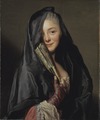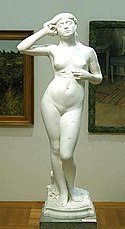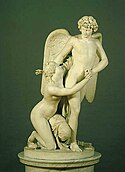Národní muzeum (Švédsko)
| Národní muzeum ve Stockholmu | |
|---|---|
 | |
| Údaje o muzeu | |
| Stát | |
| Založeno | 28. června 1792 |
| Zeměpisné souřadnice | 59°19′43″ s. š., 18°4′40″ v. d. |
| Webové stránky a Webové stránky | |
| Některá data mohou pocházet z datové položky. | |
Národní muzeum (švédsky Nationalmuseum) sídlí ve Stockholmu a je největším muzeem umění ve Švédsku.
Historie
První královskou sbírku založil král Gustav I. Vasa ve 2. třetině 16. století; postupně byla obohacována jeho následovníky a rozdělena mezi zámecké sbírky. Významné obohacení znamenala válečná kořist, přivezená z Čech za třicetileté války ze sbírek Rudolfa II. na Pražském hradě i z jiných českých fondů. Ta je dodnes z velké části v Drottningholmu. Jako národní sbírka se muzeum konstituovalo v době osvícenství roku 1792, roku 1822 vznikla samostatná Národní portrétní sbírka. K podstatnému rozšíření sbírek došlo s národně uvědomovacím hnutím během druhé a třetí třetiny 19. století. Stockholmskou budovu v neorenesančním stylu navrhl architekt Gustav Stüler roku 1866. Sbírky jsou dovedeny až do současnosti, silně je zastoupen švédský design 20. století.
Současnost
V současnosti je ve sbírkách muzea shromážděno kolem 16 000 obrazů a soch; kromě toho je zde asi 30 000 předmětů uměleckých řemesel a světově významná sbírka grafiky. Stálá expozice je uspořádána do souborů podle století, díla malířská a sochařská tvoří chronologickou osu v hlavních sálech, ostatní objekty je doprovázejí v menších postranních místnostech. Do postranních místností jsou soustředěny rovněž malé soubory, jež nezapadají do hlavního proudu (ruská díla byzantské tradice, italská gotická malba). Hlavní expozice začíná v nejvyšším patře díly 16. století. Mezi prvními jsou díla Lucase Cranacha nebo Matthiase Grünewalda. Patří sem artefakty uloupené v Čechách za třicetileté války švédským vojskem, jako obrazy Giuseppa Arcimbolda, sousoší Adriaena de Vries Venuše s amorky, bronzový model jezdeckého pomníku císaře Rudolfa II. nebo třetinový model Rudolfova oblíbeného koně. K nejvýznamnějším kolekcím patří olejomalby Rembrandtovy (Simeon s Ježíškem v chrámě; Autoportrét; Portrét mladé ženy se šperky; Svatý Petr; aj.), Franse Halse a francouzských mistrů 18.- 19. století (např. portréty francouzského krále Ludvíka XIV. a Marie Antoinetty).
Ostatní sbírky
Národní muzeum spravuje sbírky na mnoha zámcích, především královských, jako je Gripsholm, Drottningholm, Strömsholm, Rosersberg a Ulriksdal. Pod Národní muzeum dále patří Muzeum porcelánu v Gustavsbergu.
Galerie
- Lucas Cranach starší, Platba; 1532
- Matthias Grünewald: Hlava starce
- Arcimboldo:Portrét právníka Ulricha Zasia
- Adriaen de Vries:Psyché s amorky, bronz
- Rembrandt: Autoportrét
- Rembrandt: Konspirace Claudia Civila, 1661-1662
- Hubert Robert: Požár pařížské radnice roku 1772
- Johan Tobias Sergel: Líbající se milenci
- Jean-Honoré Fragonard Ruggiero se připravuje napsat Brandamantovi
- Jean-Baptiste-Isabey: Napoleon Bonaparte
- Anastasis
- Panna Maria Gruzínská
- Sv. Jiří s drakem
- Sv. Mikuláš
- Alexander Roslin: Dáma se závojem
- Carl Larsson: August Strindberg
- Anders Zorn: Svatojánský tanec
- Lauritz Andersen Ring: Snídaně
- Johan Tobias Sergel: Amor a Psýché
- Antoine Coysevox: Portrétní busta
- Christian Eriksson: Umělec
- Per Hasselberg: Akt
- A&E Design: Turn-o-Matic
- Mies van der Rohe: Křeslo
- Sigurd Lewerentz: Piano
- Stig Lindberg: Terma
Související články
Externí odkazy
 Obrázky, zvuky či videa k tématu Národní muzeum ve Stockholmu na Wikimedia Commons
Obrázky, zvuky či videa k tématu Národní muzeum ve Stockholmu na Wikimedia Commons - [1] (švédsky a anglicky)
- Šablona:DNB-Portal
- Sbírky online: [2]
Média použitá na této stránce
Autor: Ninara from Helsinki, Finland, Licence: CC BY 2.0
Rembrandt 1661-1662,
The Conspiracy of Claudius CivilisAutor: Holger.Ellgaard, Licence: CC BY 3.0
Nationalmuseum i Stockholm, entrance, bronze sculpture by Theodor Lundberg, ”Art and Handiwork”
Snöklockan, 1883
Ruggiero förbereder sig att skriva till Brandamante
Arcimboldo’s paintings show human figures made up of different objects, with the aim of representing a particular subject. Here, a pile of books and documents has been draped in a fur-trimmed gown. The face consists of birds and fishes. The portrait is assumed to be of an official or scholar, possibly the lawyer Ulrich Zasius. Arcimboldo’s allegorical paintings were held in great esteem by Maximilian II and Rudolf II. This one belonged to the imperial collections in Prague and was brought to Sweden after the Thirty Years War.
Autor: Holger.Ellgaard, Licence: CC BY-SA 3.0
Könummersystemet "Turn-O-Matic", A&E Design
Autor: Ninara from Helsinki, Finland, Licence: CC BY 2.0
Hubert Robert
The Fire of Hôtel-Dieu in Paris 1772Autor: Holger.Ellgaard, Licence: CC BY 3.0
Piano, formgivning arkitekt Sigurd Lewerentz, fanns på Stockholmsutställningen 1930.
Hetsigt kärlekspar, Johan Tobias Sergel (1740-1814)
Autor: Bjoertvedt, Licence: CC BY-SA 3.0
Antoine Coysevox (1640-1720), french sculptor. Portrait of a Man, probably the physician Jean-Baptiste Fermelhus. National Museum, Stockholm.
Autor: Holger.Ellgaard, Licence: CC BY 3.0
Stig Lindbergs eldfasta porslin "Terma"
Autor: Nationalmuseum Stockholm, Licence: CC BY-SA 3.0
Psyke, buren av amoriner, Adriaen de Vries (1556-1627)
Autor: Bjoertvedt, Licence: CC BY-SA 3.0
Russian icon from second half of the 1500s, depicting St George and the Dragon. National Museum, Stockholm ( NMI 191).
Autor: Bjoertvedt, Licence: CC BY-SA 3.0
Russian icon, mid 1500s, depicting Santa Maria Gruzhinskaja (Mother of God, the Georgian). National Museum ( NMI 264, Stockholm.
The Lady with the Veil is one of the Nationalmuseum’s best loved paintings. The woman in the portrait is partially hidden by a black silk veil. Beneath the veil she is dressed for a special occasion in white lace and pink silk. During the 18th century, theatre was an important part of the life of the upper classes. Dressing up, disguising oneself and playing dramatic roles was a common pastime. The Lady with the Veil shows how one could dress up à la bolonaise – in the style of Bologna.
The woman is smiling in a tempting fashion yet she seems to want to remain secretive. She only shows part of herself. There are many anonymous portraits of women in collections around the world. Often they have been part of a pair of portraits of man and wife – so called pendant portraits. It is not unusual for such portraits to have become separated over the years. And since the influence of the women has been underestimated in writing the history of art, their names and identities have often been forgotten. For this reason, many of Roslin’s portraits now bear the title “Unknown Woman”. But the Lady with the veil is not one of these forgotten women. For she was Alexander Roslin’s wife: the French portrait artist Marie Suzanne Giroust.
Fans were not just a practical item for social gatherings. Fans could also be used for sending secret messages. There were numerous ways of holding, opening and closing fans. Each way meant something specific. The lady with the veil has folded her fan and is using it to stroke her cheek. This might mean: I love you! It was once the artist himself who received this message while he was painting his wife. Nowadays we are the recipients as we regard the painting and perhaps we let ourselves be seduced by the veiled woman…Autor: , Licence: CC BY-SA 3.0
Russian icon depicting St Nicholas with scenes from his life. Late 1400s or early 1500s. National Museum, Stockholm ( NMI 272).
Autor: , Licence: CC BY-SA 3.0
Russian Icon from the 1500s, depicting the Anastasis. National Museum, Stockholm ( NMI 296).
Seated at the breakfast table reading the morning paper is the artist’s wife, Sigrid Kähler. Light streams in through the open door, and outside we can make out the lush green of summer. The year is 1898 and the Danish artist couple have been married for two years. The painting has been compared with Carl Larsson’s contemporary Sundborn pictures. And the newspaper – a copy of Politiken – serves as a reminder of the world outside.
Autor: Holger.Ellgaard, Licence: CC BY 3.0
Mies van der Rohes karmstol från 1927
Autor: Nationalmuseum, Licence: CC BY-SA 3.0
Amor och Psyke, 1787, Johan Tobias Sergel (1740-1814)
















































